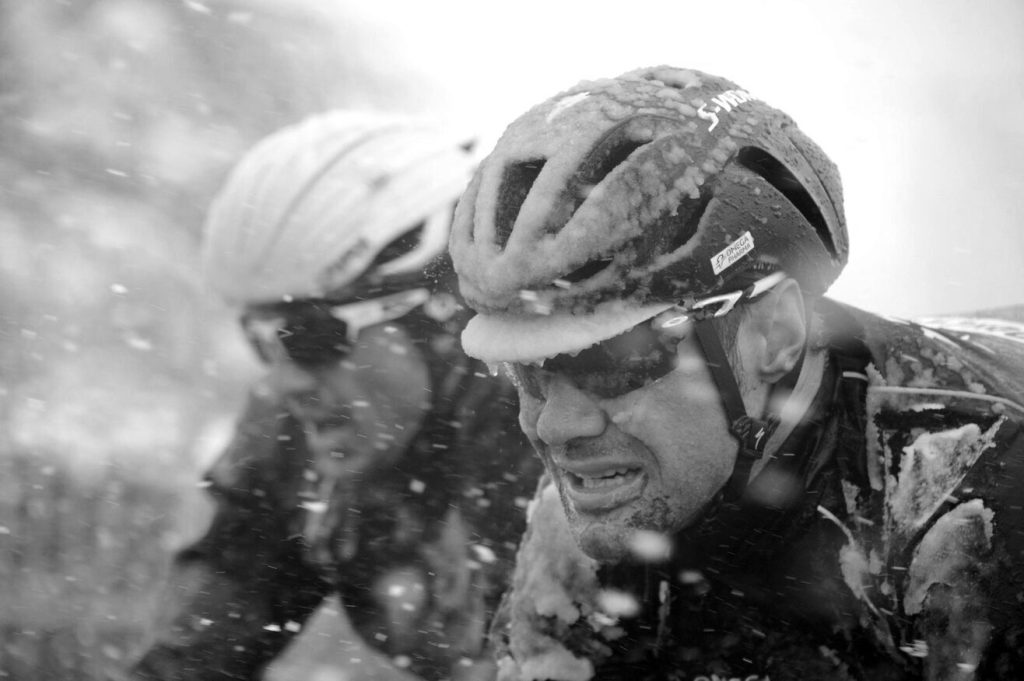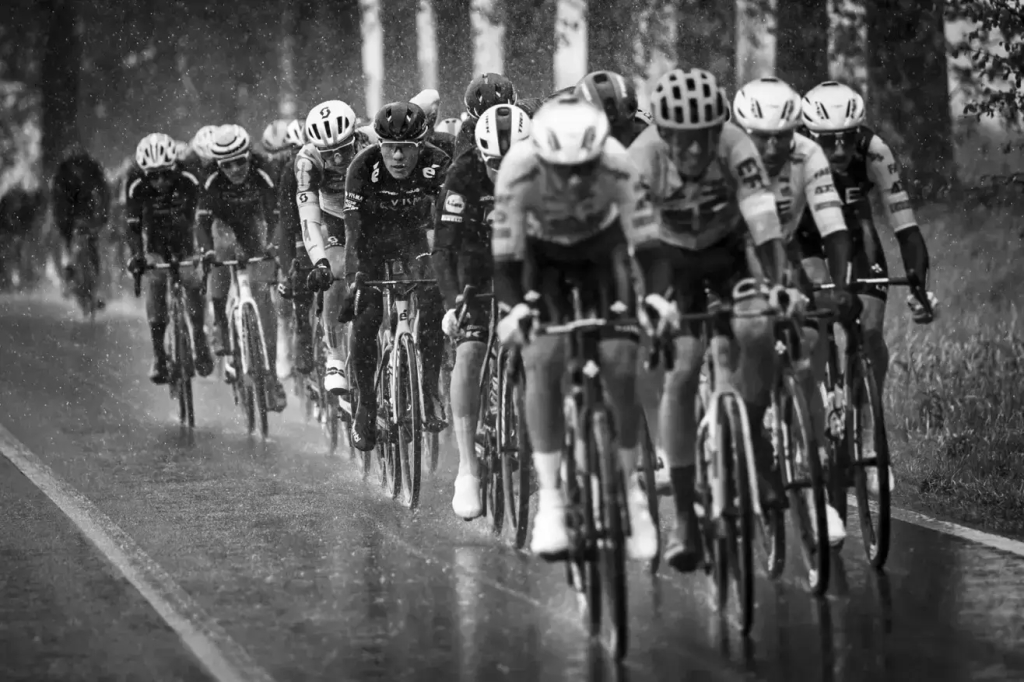‘There’s no such thing as bad weather. Just bad choice of clothing’. These words have haunted generations of young cyclists, Boy Scouts, or anyone else who dared to mention that they were cold within earshot of their male elders who seem to never tire of teaching this lesson. These wise old ones, the fathers, grandfathers, club captains and washed-up ex-pros always feel obliged to tell us us this. No doubt because it was once smugly delivered to them long ago when they too were piss-wet through and shaking like a sh*tting dog. Weather-related lessons are always learnt the hard way and no matter how experienced a rider you are, you will eventually be reminded who’s boss, Mother Nature. Long before there were rivalries like Anquetil and Poulidor, Armstrong and Ulrich, there was the rider against the elements. The cyclist’s struggle against the heavens and the earth is eternal and the sports history has been written under every imaginable variation of weather conditions. This year’s dramatic edition of La Flèche Wallonne was a ready reminder of how dramatically the weather can influence a bike race.
The 2024 Flèche Wallonne has provided another episode for the sports archive of Bad Weather Races. The race started in fair conditions, not exotic but nothing that seemed to warrant wrapping up for either. Many riders started the day in shorts, without gloves and wearing just a gilet or long sleeve. However, certain pockets of the peloton were slightly warmer dressed than others, seemingly knowing something the others didn’t. With a bit over 100km to go, there was a sudden dropping back of entire teams to the cars in order to don full rain jackets, long finger gloves, leg warmers, the works. Word soon echoed around the race that the forecast was looking bad… really bad. Within the bunch, those unable to drop back to the cars hastily zipped their gilets right up to their chins, hoping but perhaps knowing that this would not be sufficient to weather the incoming storm. I won’t waste too many words trying to describe what happened next. Just watch the highlights and you will see the epic scenes of freezing cold purgatory. It was biblical and at times difficult to watch as riders sobbed while they struggled to zip up their jackets with frozen fingers. One rider in a severe hypothermic spasm had to be lifted from his bike, carried like a sick child and placed in the team car. In the end, entire teams abandoned and only 44 of 175 riders finished.

This race wasn’t unique, we’ve all seen this before and we’ll no doubt see it again. Ghent Wevelgem 2015 springs to mind, when riders were being blown off the road into irrigation ditches. Comical from a spectator’s perspective but I expect less so from the riders’. More pertinently the 2024 Flèche Wallonne should prompt fellow students of the sport to reflect on the 1980 Liege Bastogne Liege. Known as Neige Bastogne Neige, the race was marred by severe snow and cold which decimated the field. The formidable Hinault soloed to victory wearing a ‘boil in the bag’ style rain cape, shorts and woollen mittens, while only 20 other frozen spectres followed him to the line. It begs the question, how far has clothing really come if, despite such technical advancements, bad weather can still drive a train through the bunch? The kit donned by riders in 1980 seemed to have more in common with a 1950s merchant sailor than what riders are wearing today. Modern racers are now wearing several hundred euros worth of clobber when the heavens open up. Neoprene gloves, Gabbas, Water-repellent leggings and all the rest. If the marketing hype is to be believed, the average outfit in the pro peloton contains more science than what the original Armstrong wore on the moon. However, despite this, the wind and rain wiped out 130 riders last Wednesday. Maybe they’ve gone soft?..

Irrespective of the impression an ocean of tight lycra might give, a generally macho complex or maybe even toxic masculinity make up a significant chunk of the sports collective persona. There is an expectation that cyclists not only be exceptional athletes but also hard as nails. Images of wounded competitors limping to the finish in torn shorts, covered in gauze and drying blood are synonymous with the sport. Honour trumps self-preservation, almost always. They are professionals after all no? Meaning, they are paid to ride bikes, no matter what. However, what is expected of them may depend on your definition of professionalism and the healthier mantra of ‘live to fight another day’ might be gaining more traction. Most riders who abandon do so because their professional role for the team is done for the day, or their professional obligations to the team are not being best fulfilled by getting hypothermia, crashing and missing a chunk of the season. In that sense, to abandon in certain circumstances is just as pro.
This debate arose 11 years ago following the bad weather race to end all bad weather races, Milan San Remo 2013. That edition of La Primavera will remain as the benchmark for crap weather! The peloton was covered in a thick layer of frost. Slush filled the vents in their helmets, icicles hung from their chattering jaws and the road ahead was barely visible. The organisers were forced to stop the race midway, and the riders climbed back onto their respective buses, showered and got wrapped up in dry clothes. When the race eventually reconvened many of them, including Tom Boonen never re-emerged from the bus. He said he preferred to stay healthy for the upcoming classics. His and his colleagues’ decisions not to carry on weren’t so popular. It took a special breed of hard man or idiot to step off the warm buses and go back out in those conditions to restart the race. Some no doubt felt obliged to continue and finish out of respect for a monument of cycling. Others will have been motivated by personal pride. As honourable or legitimate as any of the above reasons may be, it sparked a continuing debate. Why should these athletes be subjected to such tribulations that do their bodies, the health of which their income depends, no good at all?

As awe-inspiring as it may be to watch them battle through hellish conditions there is arguably something gladiatorial about it. Their well-being is secondary to our entertainment and if they choose to stop we pass judgment. The morality of it is questionable but there is no way to mitigate against the weather. Perhaps the increased professionalism of the sport is somehow robbing it of its lore. Or maybe more accurately, is robbing the fans of drama as they bay for blood just as they have done since the days of the colosseum. Following Neige Bastogne Neige, the victorious and frozen Hinault had to bathe in cold water so as not to shock his system. His hands were totally numb and even today he suffers from a loss of sensation in the tips of his fingers. Is a monument worth this? Apparently. Perhaps the race was actually cancelled but no one dared to tell The Badger to stop. So they reluctantly had to let him carry on.
The only full team to complete last weeks Flèche Wallonne were the Norwegian Uno X squad while the winner on the day was Welshmen Stephen Williams. Neither Scandinavia nor Wales are known for their warm weather and Williams said himself that he ‘enjoys’ racing in such trying weather conditions. Races under horrendous weather actually provide a chance for such creatures to excel. Attempts to mitigate rider suffering would actually deny them an opportunity to get their arms up while other riders are back at the hotel.
It’s an ambiguous area of the sport, juggling rider welfare with entertainment and drama, which is ultimately what keeps the ratings up and them in a job. These kinds of races certainly enrich the sports catalogue of epic stories but at what cost? Throughout most of the season, we are given the impression that they are more like machines than men. They robotically churn out kilometre after kilometre at a pace that most mortals could only dream of, but occasionally Mother Nature exposes these machines for the fragile creatures they are. The adversity of such days reveals their humanity and reminds us that pro-cycling is a play that is acted out in the real world. I’d argue that it’s this naked fragility, so susceptible to the chance and cruelty of reality that keeps us so keenly tuned in.
